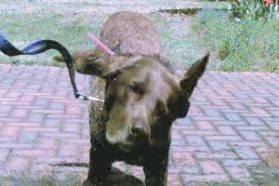Wet-dog physics
Wet, hairy animals shake at just the right speeds to get rid of water
Share this:
- Share via email (Opens in new window) Email
- Click to share on Facebook (Opens in new window) Facebook
- Click to share on X (Opens in new window) X
- Click to share on Pinterest (Opens in new window) Pinterest
- Click to share on Reddit (Opens in new window) Reddit
- Share to Google Classroom (Opens in new window) Google Classroom
- Click to print (Opens in new window) Print
Mice do it. Chihuahuas do it. So do tigers, rats and pandas. These animals really know how to shake.
Researchers at the Georgia Institute of Technology in Atlanta recently recorded video of 40 different animals, representing 15 different species. The scientists wanted to see how wet, hairy mammals shake off water after they get drenched. What the videos revealed is that animals’ shaking behavior could be described by physics — the science of matter, energy and motion. (Watch a video.)

“I think it’s pretty amazing they can do that,” David Hu told Science News. Hu is an engineer, but he’s also a mathematician and does research in biology. At his laboratory at the Georgia Institute of Technology, Hu studies the physics of fluids, which means he wants to know how fluids move and react to forces. He is particularly interested in how animals interact with water.
This study was led by Andrew Dickerson, a graduate student in Hu’s lab. His team calls this get-dry shake “nature’s analogy to the spin cycle of a washing machine.” Both the washing machine and shaking animals can get rid of water quickly — but animals are much more efficient than washing machines. For animals, this process helps them control heat in their bodies.
“If a dog couldn’t dry itself, we calculated that it would have to use 25 percent of its daily calories to heat its body to get rid of the water,” Hu told Science News. “Every time they got wet they would get hypothermia and die.”
The bigger the animal, the slower it shakes, according to Dickerson and his team. A mouse moves its body back and forth 27 times per second, but a grizzly bear shakes only four times per second.
Animals’ skin also helps them get rid of water. When the scientists placed a fluorescent straw on the back of a dog and watched the dog wiggle, they observed that the skin can move halfway down the dog’s side in either direction. Loose skin lets the dog lose more water than if the skin were tighter.
The scientists are continuing to look at how animals interact with water in the natural world. In particular, the scientists want to know how water droplets interact with hair — which means investigating animals that have adapted to life in the water, like beavers and otters.







